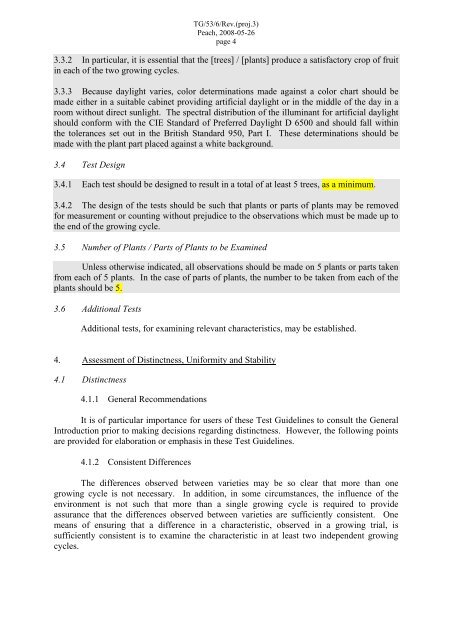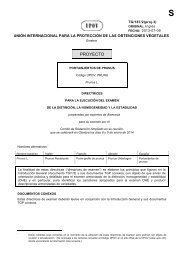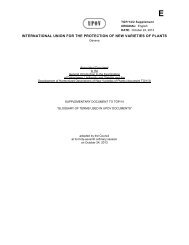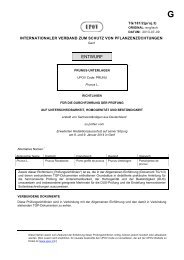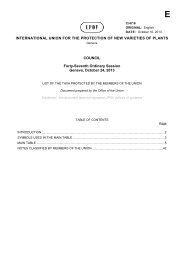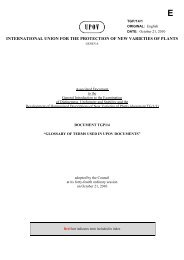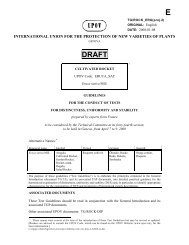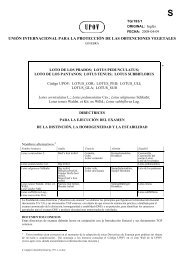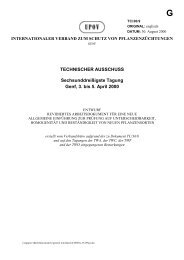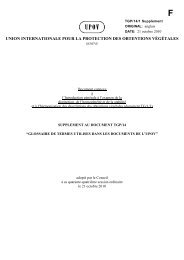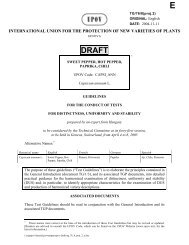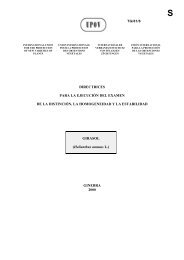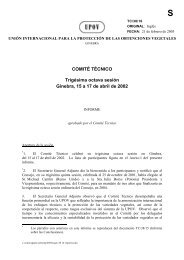draft - International Union for the Protection of New Varieties of Plants
draft - International Union for the Protection of New Varieties of Plants
draft - International Union for the Protection of New Varieties of Plants
You also want an ePaper? Increase the reach of your titles
YUMPU automatically turns print PDFs into web optimized ePapers that Google loves.
TG/53/6/Rev.(proj.3)<br />
Peach, 2008-05-26<br />
page 4<br />
3.3.2 In particular, it is essential that <strong>the</strong> [trees] / [plants] produce a satisfactory crop <strong>of</strong> fruit<br />
in each <strong>of</strong> <strong>the</strong> two growing cycles.<br />
3.3.3 Because daylight varies, color determinations made against a color chart should be<br />
made ei<strong>the</strong>r in a suitable cabinet providing artificial daylight or in <strong>the</strong> middle <strong>of</strong> <strong>the</strong> day in a<br />
room without direct sunlight. The spectral distribution <strong>of</strong> <strong>the</strong> illuminant <strong>for</strong> artificial daylight<br />
should con<strong>for</strong>m with <strong>the</strong> CIE Standard <strong>of</strong> Preferred Daylight D 6500 and should fall within<br />
<strong>the</strong> tolerances set out in <strong>the</strong> British Standard 950, Part I. These determinations should be<br />
made with <strong>the</strong> plant part placed against a white background.<br />
3.4 Test Design<br />
3.4.1 Each test should be designed to result in a total <strong>of</strong> at least 5 trees, as a minimum.<br />
3.4.2 The design <strong>of</strong> <strong>the</strong> tests should be such that plants or parts <strong>of</strong> plants may be removed<br />
<strong>for</strong> measurement or counting without prejudice to <strong>the</strong> observations which must be made up to<br />
<strong>the</strong> end <strong>of</strong> <strong>the</strong> growing cycle.<br />
3.5 Number <strong>of</strong> <strong>Plants</strong> / Parts <strong>of</strong> <strong>Plants</strong> to be Examined<br />
Unless o<strong>the</strong>rwise indicated, all observations should be made on 5 plants or parts taken<br />
from each <strong>of</strong> 5 plants. In <strong>the</strong> case <strong>of</strong> parts <strong>of</strong> plants, <strong>the</strong> number to be taken from each <strong>of</strong> <strong>the</strong><br />
plants should be 5.<br />
3.6 Additional Tests<br />
Additional tests, <strong>for</strong> examining relevant characteristics, may be established.<br />
4. Assessment <strong>of</strong> Distinctness, Uni<strong>for</strong>mity and Stability<br />
4.1 Distinctness<br />
4.1.1 General Recommendations<br />
It is <strong>of</strong> particular importance <strong>for</strong> users <strong>of</strong> <strong>the</strong>se Test Guidelines to consult <strong>the</strong> General<br />
Introduction prior to making decisions regarding distinctness. However, <strong>the</strong> following points<br />
are provided <strong>for</strong> elaboration or emphasis in <strong>the</strong>se Test Guidelines.<br />
4.1.2 Consistent Differences<br />
The differences observed between varieties may be so clear that more than one<br />
growing cycle is not necessary. In addition, in some circumstances, <strong>the</strong> influence <strong>of</strong> <strong>the</strong><br />
environment is not such that more than a single growing cycle is required to provide<br />
assurance that <strong>the</strong> differences observed between varieties are sufficiently consistent. One<br />
means <strong>of</strong> ensuring that a difference in a characteristic, observed in a growing trial, is<br />
sufficiently consistent is to examine <strong>the</strong> characteristic in at least two independent growing<br />
cycles.


